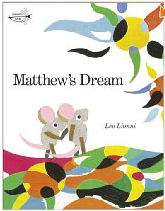 "Matthew's Dream", by Leo Lionni, is my inspiration for our third grade portfolio project. In this charming fable, a boy named Matthew visits the museum with his classmates and is entranced by the paintings he sees there. That night Matthew has a magical dream which helps him to see the world around him in a whole new way. He becomes a painter and creates beautiful abstract paintings "filled with the shapes and colors of joy". With this lesson, students will use overlapping shapes and colors to create their own beautiful abstract designs!
"Matthew's Dream", by Leo Lionni, is my inspiration for our third grade portfolio project. In this charming fable, a boy named Matthew visits the museum with his classmates and is entranced by the paintings he sees there. That night Matthew has a magical dream which helps him to see the world around him in a whole new way. He becomes a painter and creates beautiful abstract paintings "filled with the shapes and colors of joy". With this lesson, students will use overlapping shapes and colors to create their own beautiful abstract designs! 1. Talk about how artists "see things differently" by looking for the basic shapes that are found in the objects around them. Review these basic shapes (circle, square, triangle, oval, rectangle, etc., as well as "organic" shapes that are found in nature), drawing them on the board for students to refer to. As you draw them, point out items in the classroom that are made up of these shapes and ask for other examples.
1. Talk about how artists "see things differently" by looking for the basic shapes that are found in the objects around them. Review these basic shapes (circle, square, triangle, oval, rectangle, etc., as well as "organic" shapes that are found in nature), drawing them on the board for students to refer to. As you draw them, point out items in the classroom that are made up of these shapes and ask for other examples.2. Center a piece of 9"x18" construction paper on the front of your portfolio and trace around it with pencil. Draw diagonal lines from the corners of your rectangle into each corner of your portfolio. This will become your "frame".
3. Using a pencil, fill your rectangle with large, overlapping shapes. Try to use each one of the shapes on the board! It's okay to use the same shape more than once. Make sure each of your shapes overlaps at least one other shape, always striving for a balanced composition. Cropping (having shapes go "off the page") is another great technique to use here. Make sure you draw your shapes large enough and avoid creating any tiny areas where your shapes overlap.
4. Notice how your overlapping shapes have created "new shapes"!
5. Now color each of these "new shapes" with colorful markers or crayons. Make sure you change colors everywhere a new shape appears, and try to have shapes of the same color only touch at corners, if at all. (Remind students to color "all one direction" within each shape.)
6. Finally, draw some swirly lines inside your frame to imitate a fancy museum frame. You can use the side of a yellow or brown crayon to color your frame and then use the point to trace over your swirly lines, pressing harder to make them stand out.
Allow students to take a good look at the paintings created by "Matthew" in this story. Then draw examples of overlapping shapes on the board to demonstrate the way new shapes are created. As soon as this technique "clicks" for your students, they will enjoy making these fun abstract drawings often!
Such a gorgeous result!!
ReplyDeleteI just found your blog, and I love the posts where you have connected a book to the art project.
ReplyDeleteThis is great.Thank you for sharing these wonderful ideas.
ReplyDelete